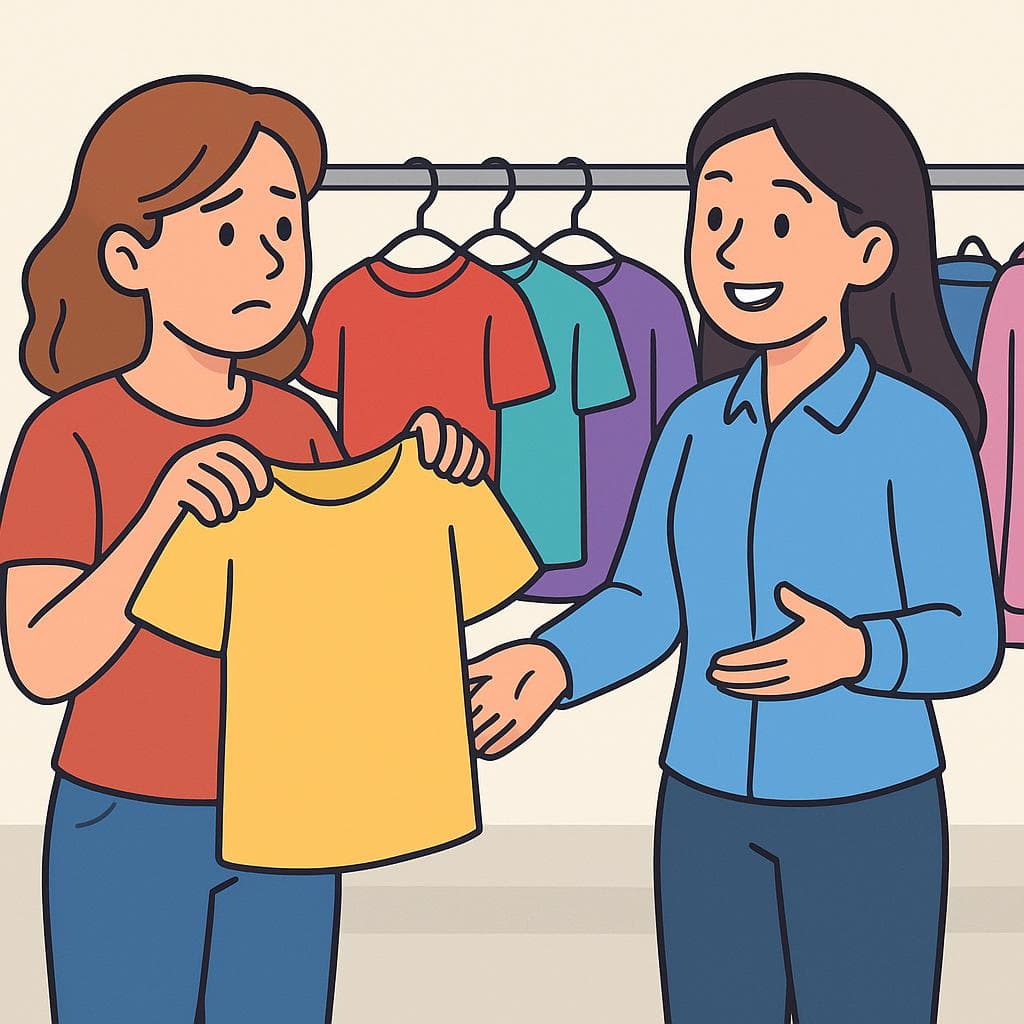Do you have this in another color?
in Spanish¿Lo tiene en otro color?
/loh TYEH-neh ehn OH-troh koh-LOR?/
This is the standard, polite way to ask a shop assistant if an item is available in a different color. It uses 'usted' (formal you), which is the safest bet in most retail interactions.

When shopping, holding up the item helps clarify exactly what you want in a different color.
💬Other Ways to Say It
¿Lo tienes en otro color?
/loh TYEH-nehs ehn OH-troh koh-LOR?/
The informal 'tú' version. Very common in casual stores, boutiques, or street markets, especially in Spain and among younger people.
¿Tienen este en otro color?
/TYEH-nehn EHS-teh ehn OH-troh koh-LOR?/
Uses the plural 'you' (ustedes). You are asking if 'the store' (they/you all) has the item. This is extremely common in Latin America.
¿Lo tenés en otro color?
/loh teh-NEHS ehn OH-troh koh-LOR?/
The 'voseo' form used specifically in the Rioplatense region (Argentina/Uruguay).
¿Hay en otro color?
/EYE ehn OH-troh koh-LOR?/
Literally 'Is there in another color?' It is impersonal and very simple to say.
¿Viene en otros colores?
/BYEH-neh ehn OH-trohs koh-LOR-ehs?/
Means 'Does it come in other colors?' Focuses on the product's manufacturing rather than the store's current stock.
¿Tenéis esto en otro color?
/teh-NAYS EHS-toh ehn OH-troh koh-LOR?/
Uses 'vosotros' (informal plural). This is specific to Spain.
🔑Key Words
Key Words to learn:
📊Quick Comparison
Choose the right phrase based on who you are talking to and where you are shopping.
| Phrase | Formality | Best For | Avoid When |
|---|---|---|---|
| ¿Lo tiene en otro color? | Formal (Usted) | Department stores, older staff, polite interactions | Talking to a friend or in a very casual setting |
| ¿Lo tienes en otro color? | Informal (Tú) | Street markets, casual boutiques, younger staff | In very high-end luxury stores (use formal) |
| ¿Tienen este en otro color? | Neutral Plural | Asking if the store (in general) has stock | You want to be very specific about a single person's inventory |
📈Difficulty Level
Standard Spanish sounds. The main challenge is rolling the R slightly in 'otro' and 'color'.
Requires basic verb conjugation (tener) and object pronouns (lo/la), but can be simplified.
Fairly straightforward, just remember to greet the person first.
Key Challenges:
- Remembering not to say 'un otro'
- Matching gender (lo vs la) to the object
💡Examples in Action
Me gusta mucho esta camisa, pero ¿la tiene en otro color?
I really like this shirt, but do you have it in another color?
Disculpa, ¿tienen este modelo en negro?
Excuse me, do you guys have this model in black?
¿Lo tienes en azul?
Do you have it in blue?
Perdona, ¿esto viene en más colores o solo en rojo?
Excuse me, does this come in more colors or only in red?
🌍Cultural Context
The Importance of Greetings
In Spanish-speaking cultures, walking up to a clerk and immediately asking 'Do you have this?' can be considered rude. It is customary to say 'Hola, buenos días' (Hello, good morning) or 'Disculpe' (Excuse me) before launching into your question about colors or sizes.
Touching the Merchandise
In open-air markets (mercados) or artisan stalls, it's polite to ask before unfolding shirts or handling delicate items. However, in modern malls and department stores (like Zara or Falabella), browsing and handling items is exactly the same as in the US or UK.
Lo vs. La
You might hear shop assistants correct your grammar slightly by swapping 'lo' for 'la'. If you are holding a shirt (una camisa - feminine), they will say '¿La quiere en otro color?' If you are holding a dress (un vestido - masculine), they use 'lo'. Don't worry if you mix them up; they will still understand you perfectly.
❌ Common Pitfalls
Saying 'Un otro'
Mistake: "Asking for 'un otro color' (translating 'an other' directly)."
Correction: Otro color
Forgetting 'En'
Mistake: "Asking '¿Tienes esto rojo?' (Do you have this red?) when you mean 'in red'."
Correction: ¿Tienes esto EN rojo?
Confusing Ser and Estar
Mistake: "Asking '¿Es en otro color?'"
Correction: ¿Viene en otro color? / ¿Hay en otro color?
💡Pro Tips
Point and Ask
If you are nervous about the grammar (lo vs la, este vs esta), simply hold up the item, make eye contact with the clerk, and ask '¿Hay en otro color?' or simply '¿En otro color?' while gesturing. Context does 90% of the work.
Learn Your Basic Colors
If you ask this question, the clerk will list what they have. Review: Negro (black), Blanco (white), Azul (blue), Rojo (red), Verde (green), and Gris (gray). If they say a color you don't know, ask '¿Me lo puede mostrar?' (Can you show it to me?).
Listen for 'Agotado'
If the answer is 'no', you might hear the word 'agotado'. This means 'sold out' or 'out of stock'. It saves you from looking around the store for something that isn't there.
🗺️Regional Variations
Mexico
Mexican Spanish is often very polite in customer service. You might hear verbs like 'manejar' (to handle/carry) used for stock: '¿No manejan este en azul?'
Spain
In Spain, the 'tú' form is much more common in retail than in Latin America. You can often speak casually to shop assistants unless it is a luxury boutique.
Argentina/Uruguay
The 'voseo' is key here. Also, shop assistants might be very informal and friendly, calling you 'amor' or 'cielo' depending on the context.
💬What Comes Next?
The clerk asks which color you want
¿Qué color busca?
What color are you looking for?
Busco uno negro / Busco algo más oscuro.
I'm looking for a black one / I'm looking for something darker.
They don't have the color, but have others
Solo me queda en verde.
I only have it left in green.
Ah, bueno. ¿Me lo puedo probar?
Ah, okay. Can I try it on?
They are checking the back room
Déjeme revisar en la bodega.
Let me check in the stockroom.
Gracias, muy amable.
Thank you, very kind.
🧠Memory Tricks
To remember the word for 'another' or 'other' (otro), imagine a cute OTTER painting the shirt a different color. 'Do you have an OTTER color?'
The verb 'Tener' (to have) sounds like 'Ten'. Imagine you have TEN items in your hand. 'Do you have (Tener) ten items?'
🔄How It Differs from English
In English, we often use 'do' as a helper verb (Do you have?). In Spanish, the verb 'tener' contains the meaning of 'do you have' all in one word. Also, Spanish requires gender agreement, so 'it' changes to 'lo' or 'la' depending on whether the item is masculine or feminine.
False Friends & Common Confusions:
Why it's different: English speakers often want to translate 'an-other' as 'un otro'.
Use instead: Just 'otro'. Never 'un otro'.
🎯Your Learning Path
➡️ Learn Next:
How to say can I try this on
Once you find the right color, the natural next step is to see if it fits.
How to ask how much is this
After selecting the color and trying it on, you'll need to know the price.
Colors in Spanish
You need to understand the answer when they tell you what colors are available.
✏️Test Your Knowledge
💡 Quick Quiz: Do you have this in another color?
Question 1 of 3
You are in a formal department store in Mexico City. You want to ask the older clerk if they have a shirt in red. Which is the best phrase?
Frequently Asked Questions
Do I need to say 'lo' or 'la' when asking?
Ideally, yes. Use 'lo' for masculine items (vestido, zapato, sombrero) and 'la' for feminine items (camisa, falda, chaqueta). However, if you make a mistake or just say 'lo' for everything, people will still understand you perfectly.
Can I just say 'More colors?'
You could say '¿Más colores?' with a rising intonation. It's not grammatically complete, but in a busy shop, it communicates the idea effectively. A slightly better short version is '¿Hay otros colores?' (Are there other colors?).
What if I want a specific color, like 'light blue'?
You can add adjectives after the color. Light blue is 'azul claro'. Dark blue is 'azul oscuro'. So you would ask: '¿Lo tiene en azul claro?'
Is it rude to use 'tú' with a shop assistant?
In Spain, generally no—it's very common. In Latin America, it depends on the context. In street markets or with peers, it's fine. In formal stores or with older staff, 'usted' is much more polite and preferred.
📚Continue Learning Spanish Phrases
Explore More Phrases in These Categories
Find similar phrases to expand your Spanish vocabulary:
Want to Learn More Spanish Phrases?
Browse our complete collection of Spanish phrases organized by situation, from basic greetings to advanced conversations. Perfect for travelers, students, and anyone learning Spanish.
View All Spanish Phrases →



